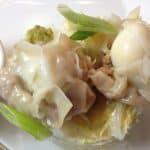Pork Siomai Dumplings with Quail Eggs
Filipinos love Chinese New Year and serve foods to invite prosperity to the home. To celebrate the Lunar New Year, I cooked these Pork Siomai Dumplings with Quail Eggs. I put one tiny quail’s egg in the middle of each dumpling before steaming it. The ground pork filling had crunchy chopped water chestnuts, scallions, soy sauce, rice wine and seasonings, giving it a flavorful Asian aroma. Steam these siomai stove top and you can enjoy these with other Chinese dishes like noodles for long life and fish for prosperity. I made this recipe from one of my mom’s archives, and it yielded 40 pieces of siomai or dumplings, about an inch in diameter. Serve this with a side dipping sauce of soy sauce mixed with lemon juice. This makes a good appetizer or main dish for any event or family meal. This is an AsianInAmericamag recipe. Serves 4.
Servings: 4 people
Calories: 660kcal
Equipment
- Steamer: Bamboo or Stainless Steel
Ingredients
- 1 pound ground pork
- 1/2 pound fresh medium-sized shrimps peeled, deveined, finely chopped
- 2 stalks scallion whites chopped
- 3/4 cup chopped water chestnuts canned; drain liquid
- 2 whole eggs
- 1/4 cup Panko bread crumbs
- 2 Tablespoons Xiao Xing rice wine or dry sherry
- 1/4 cup soy sauce
- 1/2 teaspoon salt
- 1 teaspoon white pepper powder
- 1/8 teaspoon sesame oil
- 2 cans (6.7 ounces/190 gm.) boiled quail eggs about 20 eggs in each can; or use fresh and hard-boil them
- 1/4 cup soy sauce for dipping sauce
- 2 Tablespoons calamansi or lemon juice for dipping suace
- 1 package won ton wrappers square or round; about 40 pieces
- for serving: steamed jasmine white rice
- 1 whole egg beaten with 2 Tablespoons water, for egg wash egg
Instructions
- Prepare steamer: Pre-heat bottom pan of steamer by filling with water to the brim. Start by turning heat to a high to let water boil. Grease the bamboo steamer by brushing some oil to the layer that will be used to cook the siomai. Put aside for later use.
- To make the pork filling: Combine all the ingredients, except for the quail eggs, wonton wrappers, and dipping sauce in a bowl. Blend thoroughly.
- To fill the dumplings:Take one piece of won ton wrapper. Put a tablespoon of ground pork filling in the center. Place one quail egg in the center, on top of the pork. Moisten the edges of the wrapper with a little egg wash so it seals. Gather the sides of the won ton wrapper and seal all around, using your fingers. (Note: One can of quail eggs contains about 20 pieces. You can also cook the dumplings in the same manner even without the little eggs in the center).
- To cook the dumplings: Place about 18 pieces of dumplings in a pre-greased flat plate that can fit inside the bamboo steamer. Leave about ½ inch space between dumplings. Do not crowd dumplings or when cooked, the won ton wrappers may stick to each other and you’ll end up with a big lump instead. (Note: I used a bamboo steamer, thus I had to put dumplings in a plate to go inside the steamer. If you are using a metal steamer, then grease insides and place the dumplings directly to cook. No need for a plate in this case).
- Over high heat, while the water in the bottom of the steamer is rapidly boiling, cover and steam the dumplings. Cook for 25 to 30 minutes. Pork must be cooked thoroughly.
- When cooked, remove the dumplings carefully from the steamer, by using a flat turner. Arrange on a platter. Serve the siomai warm with fragrant jasmine rice or a noodle dish.For the dipping sauce: Combine the soy sauce and lemon juice for a side sauce to be served alongside the pork siomai
- Cook’s comments: The canned quail eggs are already cooked hard boiled and peeled. If preferred, fresh quail eggs are sold at Asian markets. Cook the fresh eggs hard-boiled for 10 minutes in boiling water. Then peel off shells to use for this recipe. They can be found in Asian groceries.
- Hello, Friends! All the images and content on this blog are COPYRIGHT PROTECTED and owned by my media company Besa-Quirino LLC. This means BY LAW you are NOT allowed to copy, scrape, lift, frame, plagiarize or use my photos and recipe content I wrote, on your website,books, films, television shows or videos without my permission. If you want to republish this recipe or content on another website, video, news article,or media outlets mentioned above please ASK my permission, re-write it in your own words and simply link back to this blog to give proper attribution. It’s the legal thing to do. Thank you. Email me at [email protected]
Nutrition
Serving: 1g | Calories: 660kcal | Carbohydrates: 69g | Protein: 34g | Fat: 26g | Saturated Fat: 9g | Cholesterol: 95mg | Sodium: 2646mg | Potassium: 479mg | Fiber: 2g | Sugar: 1g | Vitamin A: 16IU | Vitamin C: 1mg | Calcium: 81mg | Iron: 6mg
